Landblog Main
previous archive
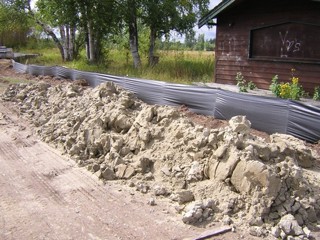 Clay! -- 4 September 09 -- I've been checking the craigslist free stuff list all summer, and just got a stroke of luck. A guy named Steve, who runs Search Dog North Idaho, has arranged for a bunch of clay, excavated from the Sandpoint Bypass project, to be donated to local artists. He says cob building is definitely an art, and I can have as much as I want. Yesterday I took the passenger seat out of the truck again and drove up and hauled the first load to the land.
Clay! -- 4 September 09 -- I've been checking the craigslist free stuff list all summer, and just got a stroke of luck. A guy named Steve, who runs Search Dog North Idaho, has arranged for a bunch of clay, excavated from the Sandpoint Bypass project, to be donated to local artists. He says cob building is definitely an art, and I can have as much as I want. Yesterday I took the passenger seat out of the truck again and drove up and hauled the first load to the land.I'm doing a shake test on it now, and should know the composition in a month, but it looks like almost 100% pure clay. And it's surprisingly easy to load and unload -- much easier than gravel. The only limit is how much time and energy I have to drive to Sandpoint and back.
 Pale Brown Gold -- 8 September 09 -- Here's some of the stuff I've hauled up in the last month: cylinders, lava rock, clay, and between the clay and cylinders, you can see the patch of wild oregano. Behind the stack of 21 cylinders you can barely see another stack of 21, and another eight have already been moved up the hill. The pile of lava rock is about half of the total -- the rest has already been used to fill water trenches, or has yet to be dug out of the back garden of the guy who's giving it away. And that's somewhere from 3000-3500 pounds of clay, hauled up from north of Sandpoint in five loads, one last Thursday, and two on Sunday and two on Monday over Labor Day weekend.
Pale Brown Gold -- 8 September 09 -- Here's some of the stuff I've hauled up in the last month: cylinders, lava rock, clay, and between the clay and cylinders, you can see the patch of wild oregano. Behind the stack of 21 cylinders you can barely see another stack of 21, and another eight have already been moved up the hill. The pile of lava rock is about half of the total -- the rest has already been used to fill water trenches, or has yet to be dug out of the back garden of the guy who's giving it away. And that's somewhere from 3000-3500 pounds of clay, hauled up from north of Sandpoint in five loads, one last Thursday, and two on Sunday and two on Monday over Labor Day weekend. It's only 47 miles from the land to the clay pile, but it turns out it takes about 80 minutes to drive it. Adding the time to load and unload and eat, it's about four hours from the beginning of one run to the beginning of the next, and each run burns almost exactly three gallons of gas. You can only get in on Sundays when they're not doing construction, but I'm going to try to do at least eight more runs before I close the land for winter, which will reduce the time I have to work on other projects. But in this sandy region, pure raw clay is more precious than gold (which is terrible for building). In the most plausible collapse scenario, where humans survive at a lower energy level, it's likely that in 100 years someone will still be giving or trading the clay I'm gathering this fall, for cob mortar or earth ovens or pottery.
The Tent Platform -- 19 September 09 -- A few years ago Chris helped me dig a spot near the bottom of the north hill, where I was planning to build a cabin. Then this year I got a really nice canvas wall tent from davistent.com, and put it there temporarily. Then I decided that the spot was too dark in the winter, too small, and too unstable for the cabin, and that I'd keep the tent there permanently. Since then, almost every visitor has told me I should put it on a platform. It will help keep it dry, and apparently some people would rather sleep on a wooden floor than on the ground.
 Here we're looking west, and you can see the tent in the background, where I moved it to get it out of the way. It's ten feet by twelve, and I decided to build the platform to go completely inside the tent, and exactly fit it. After sketching a few designs, I chose a bunch of ten foot boards laid on perpendicular beams. Originally I was going to lay cedar beams straight on the ground, but Sean had the idea you see here, to put them up on rocks. Last month, after carefully measuring the distance between the tent supports, I went up on the north hill and found three relatively straight and fresh ponderosa pine logs, cut them to 142 inches, and hauled them down.
Here we're looking west, and you can see the tent in the background, where I moved it to get it out of the way. It's ten feet by twelve, and I decided to build the platform to go completely inside the tent, and exactly fit it. After sketching a few designs, I chose a bunch of ten foot boards laid on perpendicular beams. Originally I was going to lay cedar beams straight on the ground, but Sean had the idea you see here, to put them up on rocks. Last month, after carefully measuring the distance between the tent supports, I went up on the north hill and found three relatively straight and fresh ponderosa pine logs, cut them to 142 inches, and hauled them down. For me, the easiest and funnest part of the whole project was getting the logs and boards level and square, because I enjoy making precise measurements and tiny adjustments. I would move the corner rocks and then raise and lower them by stuffing dirt under them or wiggling them to push dirt out. Then I laid the boards on and did a few more adjustments. To make sure the whole thing was square, I measured the diagonals, and they were even closer than I was expecting: 186¼ inches in each direction. Here you can see the boards all laid out. After looking at prices and doing some math, I figured out that 2x8's were the best value. Then I had to do some more math to get the long side to come out to 142 inches. 2x8's are actually 7¼ inches wide, and 2x4's are 3½, so nineteen 2x8's and one 2x4 are just over 141, and the inevitable cracks, from the boards not fitting perfectly, gets it to 142.
For me, the easiest and funnest part of the whole project was getting the logs and boards level and square, because I enjoy making precise measurements and tiny adjustments. I would move the corner rocks and then raise and lower them by stuffing dirt under them or wiggling them to push dirt out. Then I laid the boards on and did a few more adjustments. To make sure the whole thing was square, I measured the diagonals, and they were even closer than I was expecting: 186¼ inches in each direction. Here you can see the boards all laid out. After looking at prices and doing some math, I figured out that 2x8's were the best value. Then I had to do some more math to get the long side to come out to 142 inches. 2x8's are actually 7¼ inches wide, and 2x4's are 3½, so nineteen 2x8's and one 2x4 are just over 141, and the inevitable cracks, from the boards not fitting perfectly, gets it to 142.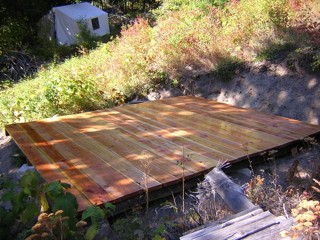 The most challenging part of the project was nailing the boards down, because I have terrible hand-eye coordination. So no matter how much I cleared my thoughts and focused my attention, I inevitably missed. If I was lucky, I missed the nail completely, but more often I hit it in a way that bent it, and then I had to carefully straighten it by hammering it sideways braced against a rock. And all of this was after I drilled 100 pilot holes to ¾ the width of the nail. Also, a few of the boards got wet in the rain and spiraled, so I had to use extra nails to straighten them out. I put two nails on each end of each board, and one nail in the center. And to get the center nails in the right spot, I did the two ends first, where I could see the beam, and then stretched a piece of string on two tacks, and drilled holes all along the string.
The most challenging part of the project was nailing the boards down, because I have terrible hand-eye coordination. So no matter how much I cleared my thoughts and focused my attention, I inevitably missed. If I was lucky, I missed the nail completely, but more often I hit it in a way that bent it, and then I had to carefully straighten it by hammering it sideways braced against a rock. And all of this was after I drilled 100 pilot holes to ¾ the width of the nail. Also, a few of the boards got wet in the rain and spiraled, so I had to use extra nails to straighten them out. I put two nails on each end of each board, and one nail in the center. And to get the center nails in the right spot, I did the two ends first, where I could see the beam, and then stretched a piece of string on two tacks, and drilled holes all along the string.Anyway, I eventually got the nailing done, and then coated the whole thing with raw linseed oil, after I found out that "boiled" linseed oil is not actually boiled, but has toxic solvents and heavy metals added to make it dry faster. Next week is supposed to be hot and sunny, so that should dry the oil enough that I can cover it for winter.
Little Things -- 1 October 09 -- The worst part of solo homesteading is that you can't divide up the jobs and just do the ones you like. You have to do them all, and on this trip I didn't feel like doing anything. But the weather was perfect: 60 degrees, overcast, and dry. So I just forced myself to take care of a bunch of little things. On Monday I put the canvas tent away, because it needs to be put away dry, and it's only going to get wetter from here on. Also I covered the tent platform with tarps, cut some grass for next year's cob, transferred all the coffee chaff from garbage bags into one of the barrels I got this year, and spent a couple hours cleaning up tens of thousands of tiny bits of pink plastic fiber that came off the carpet I was using as a crossbow target. I've thrown the carpet away, and don't know what I can shoot the crossbow at next year. Maybe carpet that doesn't shed as easily, or old wool carpet if I can find it, or straw bales.
 Here are some cob test bricks I made, with pure clay, coarse granite sand with a bit of silt, and native reed canarygrass. The numbers carved on top are the clay percentages: 20, 10, and 30. After they dry, I'll see how easily they break, and then do more tests to get the optimum percentage, or the lowest percentage that's good enough. The hardest part of making them was getting the clay in usable form. I soaked some chunks in water overnight, and then the next day I repeatedly stirred the bucket with a piece of wood and pounded the lumps out, until it was a uniform smooth thick texture that formed soft peaks just like meringue.
Here are some cob test bricks I made, with pure clay, coarse granite sand with a bit of silt, and native reed canarygrass. The numbers carved on top are the clay percentages: 20, 10, and 30. After they dry, I'll see how easily they break, and then do more tests to get the optimum percentage, or the lowest percentage that's good enough. The hardest part of making them was getting the clay in usable form. I soaked some chunks in water overnight, and then the next day I repeatedly stirred the bucket with a piece of wood and pounded the lumps out, until it was a uniform smooth thick texture that formed soft peaks just like meringue.On the last day I moved a small slash pile and built a "bypass" to connect one path more directly with another path, sawed some more wood, did the first sharpening of the chain saw chain, dug more holes for plants, and fastened a tarp over the one stick pile that I need to burn this winter, because it has a barrel in it that needs to be burned clean. Which reminds me that I figured out a trick to get the barrel dry. It still had some liquid in it, don't know what but it looked and smelled like dirty gasoline. So I put it mostly on its side hoping the stuff would evaporate faster than rainwater got in. But it didn't evaporate and apparently blocked the water from evaporating. So I stuffed some dried out hound's tongue plants in, and over the last few weeks they wicked everything up and catalyzed the evaporation.
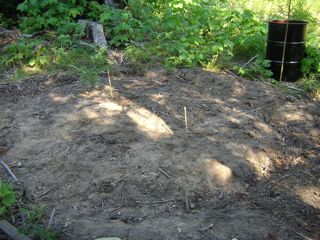 How to Make an Ellipse -- 9 October 09 -- A circle is defined by one point, the center, and one distance, the radius. An ellipse is defined by two points and a distance. Each point is called a focus (plural foci), and the distance is the sum of the distances to each one. This photo, taken in early August, shows the first stage of drawing an ellipse on the ground: pound two thin stakes, tie a string between them with plenty of slack, and move another stick around as far as the string lets it go. The sticks here are bamboo that was shipped with tree saplings to keep them straight.
How to Make an Ellipse -- 9 October 09 -- A circle is defined by one point, the center, and one distance, the radius. An ellipse is defined by two points and a distance. Each point is called a focus (plural foci), and the distance is the sum of the distances to each one. This photo, taken in early August, shows the first stage of drawing an ellipse on the ground: pound two thin stakes, tie a string between them with plenty of slack, and move another stick around as far as the string lets it go. The sticks here are bamboo that was shipped with tree saplings to keep them straight.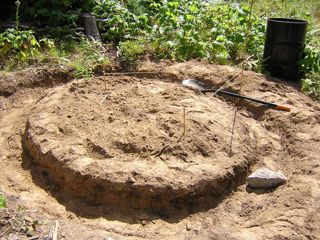 And here it is after more work. At the outside edge, the trench is roughly ten feet by nine feet. I knew at the beginning that I wanted those dimensions, so before I did any digging I did some math to figure out that I should use a ten foot string and put the foci four feet apart. It turns out that the long diameter of the ellipse is always equal to the length of the string. If the foci are in the same spot, the "short" diameter is the same as the long and you have a circle. As the foci get farther apart, the short side gets shorter. You might notice that the long side of the ellipse is facing the sun.
And here it is after more work. At the outside edge, the trench is roughly ten feet by nine feet. I knew at the beginning that I wanted those dimensions, so before I did any digging I did some math to figure out that I should use a ten foot string and put the foci four feet apart. It turns out that the long diameter of the ellipse is always equal to the length of the string. If the foci are in the same spot, the "short" diameter is the same as the long and you have a circle. As the foci get farther apart, the short side gets shorter. You might notice that the long side of the ellipse is facing the sun. 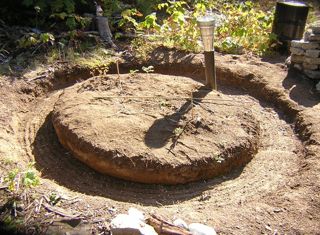 I would dig a bit, run the stick around on the string, and dig a bit more, with the goal of a sixteen inch trench extending about three inches beyond the limit of the string. This isn't quite that precise, and the uphill side is a few inches higher than the downhill side, but at a certain point I said good enough, ran a rake around the bottom to smooth it out, and waited for a good rain to soak it before I went to the next step.
I would dig a bit, run the stick around on the string, and dig a bit more, with the goal of a sixteen inch trench extending about three inches beyond the limit of the string. This isn't quite that precise, and the uphill side is a few inches higher than the downhill side, but at a certain point I said good enough, ran a rake around the bottom to smooth it out, and waited for a good rain to soak it before I went to the next step. Continuing with my very successful policy of not writing about anything until after I've done it, I'm not going to say where I'm going with this, but you can probably guess. In the bottom of the trench is a bunch of "urbanite" I hauled up from Spokane. It wasn't quite enough, so I found some rocks to fill in the bigger gaps. Now I'm going to let it sit over the winter and settle a bit, and do the next stage in the spring. That thing sticking up, by the way, is the input for a greywater sump that Chuck donated. See the August 30 post for more info.
Continuing with my very successful policy of not writing about anything until after I've done it, I'm not going to say where I'm going with this, but you can probably guess. In the bottom of the trench is a bunch of "urbanite" I hauled up from Spokane. It wasn't quite enough, so I found some rocks to fill in the bigger gaps. Now I'm going to let it sit over the winter and settle a bit, and do the next stage in the spring. That thing sticking up, by the way, is the input for a greywater sump that Chuck donated. See the August 30 post for more info.Donations and Transplants -- 26 October 09 -- In the middle of this month I drove the truck over to Seattle for nine days, and while I was there I picked up some nice stuff from Bob. Previously he donated a plastic worm bin that I've been using for storage, and two 55 gallon barrels with removable lids, which are a commodity. If someone is giving away a free 55 gallon barrel, usually it has a sealed lid and some kind of mystery toxin inside. This time Bob donated a third barrel with about ten gallons of asphalt emulsion, which is relatively non-toxic and good for coating wood to stick in the ground. Also he gave me a nice homemade tamper -- a tool for tamping earth foundations and floors -- made of a one foot square plate attached to a pipe. And a few slabs of rock, three different trowels, and a gallon of linseed oil.
This was probably my last long visit this year. I stayed two nights and spent the middle day eating and keeping warm, because it was cold and rainy. But on the first and third days I dug some holes and did five transplants. First I moved the serviceberry that you can see inside the ellipse in the previous post, and then four black currants that I planted back in 2005 on the south edge. Now they'll get more sunlight and better care -- if they survive transplanting. Everything went in the new intensive orchard area, just downhill from the spring by the upper cherries. Also I planted three patches of sweet cicely seeds, and carefully placed a few chickweed seedballs.
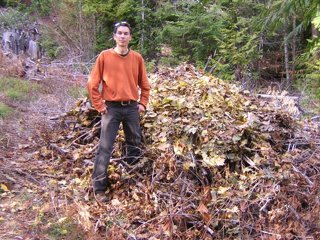 Leaves -- 10 November 09 -- Early November is leaf trading season in Spokane, and right now the market runs the whole range from "I can't believe you'll haul my bagged leaves away for free" to "If you want them, you have to rake them yourself and I'll be watching." I don't think that guy got any takers, but in a few years, when more people are growing their own food and needing to build topsoil, he might. This year it was no problem for me to make four leaf runs around the city and haul up three truckloads in five days, a total of 47 garbage bags full. I covered six stick piles with leaf hats, which will keep the sticks moist and warm so they break down faster, and also made a four foot all-leaf pile with enough mass that when I stuck my hand in the center, the heat was uncomfortable.
Leaves -- 10 November 09 -- Early November is leaf trading season in Spokane, and right now the market runs the whole range from "I can't believe you'll haul my bagged leaves away for free" to "If you want them, you have to rake them yourself and I'll be watching." I don't think that guy got any takers, but in a few years, when more people are growing their own food and needing to build topsoil, he might. This year it was no problem for me to make four leaf runs around the city and haul up three truckloads in five days, a total of 47 garbage bags full. I covered six stick piles with leaf hats, which will keep the sticks moist and warm so they break down faster, and also made a four foot all-leaf pile with enough mass that when I stuck my hand in the center, the heat was uncomfortable.Plant Orders -- 11 November 09 -- Yesterday I ordered next spring's plants from three nurseries. I was planning to start with five American plums (Prunus americana). I don't much like European or Asian plums, but American plums, being wilder, have denser and more variable flavor, so I might like them better, and they're much easier to grow. The University of Idaho nursery had them for the incredible price of $2 each with a minimum order of five, but they were sold out, so I found them for $9 at Prairie Moon and ordered only three. Prairie Moon also happens to be one of the few sources of Allium tricoccum, known as wild leeks or ramps, and according to Dave Jacke "one of the few truly excellent food crops that can grow in full shade." So I added half an ounce of ramp seed.
Next, from Burnt Ridge, I ordered two blue elderberries (Sambucus caerulea), four paw paw seedlings (Asimina triloba), five black walnut seedlings, and a Gamma hazelnut to pollinate the Barcelona I planted a few years ago. Blue elder is the variety native to my region, and all the ones I've planted before have died, except one, which has grown more than all seven apple trees combined. Paw paw is the largest fruit native to North America, looks like a mango and tastes like a banana, and the tree is hardy to -20F. It hasn't been bred much, so so there's little difference between random seedlings and expensive named varieties. And I buy cheap seedlings of black walnut because walnuts have a high "infant mortality" rate in this dry climate, and I expect to plant three or four for every one that survives.
Finally, from Raintree, I got an Arctic Jay white nectarine to replace the one that died last winter, a Chinese sweet pit apricot to replace the one that died the winter before that, three Jostaberries (a gooseberry black currant cross), and two mountain ash hybrids, Ivan's Belle and Ivan's Beauty. Belle is crossed with hawthorn and Beauty with aronia, both make tasty small fruits, and I couldn't decide which one to get to fill the spot where the Tomcot apricot died, so on impulse I got both, and I'll put the other one where the fifth American plum was going to go, by the upper cherries. Raintree has high prices but also offers a 20% bonus for early orders, so I used that to get an Orus 8 (another gooseberry currant cross to replace the fourth plum), a bundle of 25 strawberries for the backyard at my mom's house, and some label tags.
Total price after tax and shipping: $59.00 from Prairie Moon, $71.74 from Burnt Ridge, and $155.51 from Raintree, for a total of $286.25, and 23 new plants to water next year. But 13 of them are all going in the same area just down from the spring, and I find that the total watering job stays about the same year after year, as older plants either die or get established.